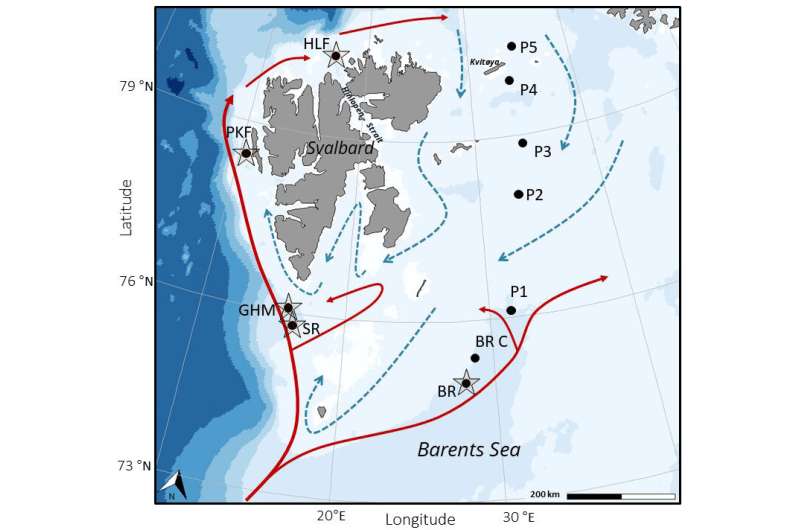Study: Methane emissions in Arctic diversify the diets of marine ecosystems living in productive shallow-marine areas

It is well established that deep-sea ecosystems living in natural cold seep sites around the world thrive in areas where their only food source is limited to the uptake of carbon through chemosynthesis. However, it wasn't until now that we discovered how these natural methane seep sites influenced the diet of Arctic ecosystems in shallow-marine areas, such as the Barents Sea.
Published in Frontiers in Marine Science, the findings from the recent study, led by Dr. Emmelie Åström (former CAGE Ph.D., UiT/Nansen Legacy), brings new knowledge and understanding of the communities thriving in cold seeps located at shallow Arctic shelves.
Food is crucial for the success of all ecosystems, with communities adapting their diet according to the type of food that is available. For some deep-sea ecosystems, communities depend on the release of chemical compounds that can be found at cold seep sites. Here, organisms are largely reliant on using chemosynthesis to uptake the carbon (for example, methane) coming from the gas emissions as an alternative food source to the use of photosynthesis, since light cannot reach the deep-ocean.
Methane gas from cold seeps—a complementary food source?
Cold seeps have been observed around the world, and the Barents Sea is no exception. In fact, it is a hot spot where many cold seep areas have been recently discovered with methane gas flowing out from the seabed. While it is well-known that deep-sea ecosystems use the methane found in cold seeps, it has been uncertain, until now, whether communities living in productive Arctic shelves, such as in the Barents Sea, also use the hydrocarbons emitted from the seep sites as a food source when they are able to use photosynthesis.
Åström and co-authors undertook stable isotope analyses of nitrogen and carbon from different organisms and combined known food-web baselines from surrounding environment to test the hypothesis that chemosynthesis-based carbon is being used by a variety of non-chemosymbiotic organisms at numerous cold seep sites in the productive and relatively shallow Barents Sea.
This study was conducted together with CAGE Work Package 6 (Pleistocene to Present: Methane, Ocean Acidification and CO2) leader, Professor Tine Rasmussen, and the material and data was acquired during numerous CAGE research cruises.
"Based on the findings from this study, we found that non-chemosynthetic communities on the seafloor are utilizing the hydrocarbons from the seabed seeps to their benefit, as an additional energy source alongside their usual photosynthetic diet," says Emmelie Åström, who conducted this study together with CAGE WP6 leader, Professor Tine Rasmussen.
The coupled reaction of anaerobic oxidation of methane and reduction of sulfate at the seabed, creates the basis for chemosynthesis and symbiotic animals to nourish from this process. Like photosynthesis, where plants derive energy from sunlight, chemosynthesis assimilates energy from the chemical compounds that have been processed by microbes.
Therefore, instead of seaweed or algae, microbes are the base of the marine chemosynthetic food-chain. Specialized animals can have a relationship with such microbes that can sustain them with energy—know as a symbiotic relationship. In addition, the chemosynthetic energy source can enter the food web by animals grazing microbial mats or by traditional predator-prey interactions.
Important knowledge about the environment in the Barents Sea
The interest of cold seep locations from the petroleum industry has previously led to several studies in geophysics and chemistry in such areas. However, the ecology of these sites have been less investigated and recently cold seeps in the Norwegian marine sector are recognized as special and vulnerable areas with high conservation value.
"Our study shows that the seep-sites are important habitats as they increase the niche-diversity and adds resources to Arctic benthic communities. Altogether, cold seep systems can act as hot-spot systems at the seabed, also in these relatively shallow Arctic waters," says Åström.
The fact that carbon sources derived via chemosynthesis does not only occur in isolated areas in the deep sea with a limited supply of organic material via photosynthesis, but also take place in highly productive Arctic shallow bottom areas highlights the multi-varying effects of cold seeps.
"As the number of discovered cold seeps in the Arctic increases, it is likely that the use of chemosynthesis-based carbon in 'background' taxa is much more prevalent than previously thought," Åström concludes.
More information: Emmelie K. L. Åström et al, Chemosynthetic and photosynthetic trophic support from cold seeps in Arctic benthic communities, Frontiers in Marine Science (2022). DOI: 10.3389/fmars.2022.910558
Journal information: Frontiers in Marine Science
Provided by UiT The Arctic University of Norway




















